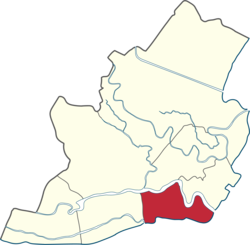Iloilo City Proper
La Punta (Spanish) Downtown Iloílo | |
|---|---|
Administrative and central business district | |
From top, left to right: Skyline; Eusebio Villanueva Building; San Jose Church; Old Iloilo City Hall; Museum of Philippine Economic History; Iloilo Customs House; Casa Real de Iloilo | |
| Nickname(s): Old Iloilo, Heart of Iloilo | |
| Motto(s): La Muy Leal y Noble Ciudad (The Most Loyal and Noble City) | |
 Location within Iloilo City | |
 | |
| Coordinates: 10°41′42.7194″N 122°33′52.92″E / 10.695199833°N 122.5647000°E | |
| Country | |
| Region | Western Visayas (Region VI) |
| Province | Iloilo (geographically only) |
| City | Iloilo City |
| Congressional District | Lone district of Iloilo City |
| Established | 1602 |
| Cityhood | October 5, 1889 |
| Reincorporated (as district) | July 16, 1937 |
| Barangays | 45 (see Barangays) |
| Government | |
| • Mayor | Jerry Treñas (Mayor of Iloilo City) |
| Area | |
| • Total | 3.75 km2 (1.45 sq mi) |
| Population (2020 census) | |
| • Total | 46,350 |
| • Density | 12,360/km2 (32,000/sq mi) |
| Demonym | Ilonggo |
| Time zone | UTC+8 (Philippine Standard Time) |
| ZIP code | 5000 |
| Area code | 33 |
| Patron saint | Santo Niño (district patronal saint) |
| Feast day | Fourth Sunday of January in honor of Señor Santo Niño or Holy Child Jesus (coincides with Dinagyang Festival) |
| Native languages | Hiligaynon |
| Website | www |
Iloilo City Proper, also known as Downtown Iloilo or simply Iloilo among locals, is an administrative district in Iloilo City, Philippines, located on the southeastern coast of the island of Panay in the Western Visayas region. It serves as the civic center of the city and province of Iloilo, hosting the seat of city and provincial governments, as well as various local, provincial, and regional government offices. According to the 2020 census, it has a population of 46,350 people.[1][2]
Before its consolidation with the surrounding municipalities, Iloilo City Proper was the old town and the original city of Iloilo. Established in 1602, it gained cityhood status on October 5, 1889 through a royal decree, and was honored with the title "La Muy Leal y Noble Ciudad" (The Most Loyal and Noble City). In 1898, it served as the last capital of the Spanish Empire in Asia and the Pacific.
In modern times, Iloilo City Proper is known for its well-preserved 19th and 20th-century architecture, particularly along J.M. Basa Street, popularly referred to as Calle Real. It remains one of the major business districts of the city, alongside the rapidly developing district of Mandurriao.
- ^ "Iloilo...My City...My Pride". Archived from the original on January 21, 2012. Retrieved February 20, 2012.
- ^ 2021–2029 Iloilo City Comprehensive Land Use Plan (CLUP) Volume 1









